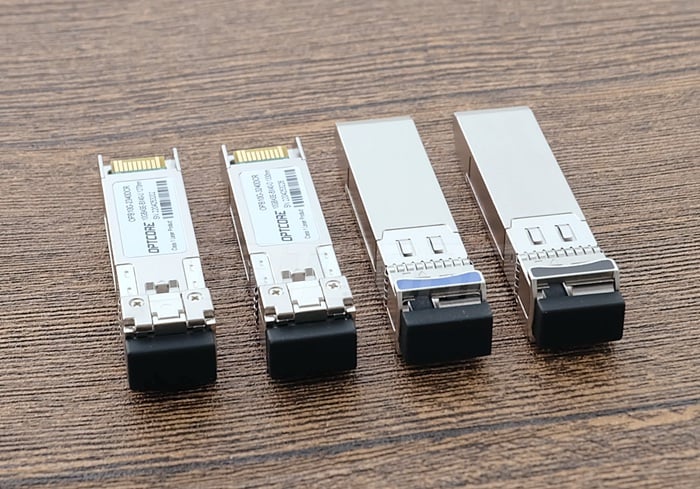-
×
 10Gb/s XFP BiDi 1270nm-TX/1330nm-RX 10km Transceiver
1 × US$ 89.00
10Gb/s XFP BiDi 1270nm-TX/1330nm-RX 10km Transceiver
1 × US$ 89.00
Blog, Optical Transceiver
What is BiDi Transceiver: A Beginner’s Guide
Estimated reading time: 7 minutes
Our previous blog covered many basics about optical transceivers and various package types, such as SFP, SFP+, QSFP, QSFP28, XFP, etc. However, we overlooked a widespread and widely used type: the BiDi transceiver. As a technical engineer with many years of experience in optical modules, I want to discuss this topic with you.
This article will explain the BiDi optical transceiver, analyze its advantages and disadvantages, discuss applicable application scenarios, and introduce the various common types of BiDi transceivers. Now, Let’s go on.
What is a BiDi Transceiver?
BiDi transceiver, or Bidirectional or simplex optical transceiver, is an optical module that uses Wavelength Division Multiplexing (WDM) technology to transmit and receive data over a single-strand fiber simultaneously. It achieves simultaneous bi-directional communication by using different wavelength signals at the receiving and transmitting ends, thus achieving the effect of a conventional duplex fiber with only one fiber.
The BiDi module integrates the conventional TOSA and ROSA into a single fiber connector, often called BOSA. Inside the BOSA, there is an optical filter that enables wavelength separation. The diagram below visualizes the working principle.

Take the most common BiDi SFP module as an example. One module typically uses 1310nm on the transmitter side and 1550nm on the receiver side. The module at the other end must use 1550 nm at the transmitter and 1310 nm at the receiver end to achieve wavelength matching. Therefore, all BiDi modules must be used in pairs. Otherwise, the wavelength mismatch will cause a failed connection.
Advantages of BiDi Transceiver
1. Save half of the fiber resources
BiDi transceivers require only a single fiber for bi-directional data transmission. Compared to traditional dual-fiber networks, only a typical fiber is needed to achieve the same data transmission, thus significantly reducing the amount of fiber used. This significantly saves fiber optic cabling and maintenance costs, mainly when fiber resources are limited or have high cabling costs.
2. Savings in overall network facility costs
The overall network deployment cost is reduced as fiber usage is reduced. The reduced need for fiber laying, management, and maintenance results in a lower overall cost for network infrastructure.
3. Improve fiber utilization efficiency
BiDi transceivers utilize wavelength-division multiplexing (WDM) technology to simultaneously send and receive optical signals using different wavelengths on a single fiber. That allows the network with traditional dual-fiber cabling to be doubled in size, significantly improving fiber utilization efficiency.
4. Simplify the network infrastructure
Using a single optical fiber for BiDirectional transmission simplifies the network wiring structure, reduces the complexity of wiring and physical space occupation, and makes the network neater and easier to manage.
5. Easy to upgrade and expand
BiDi transceivers can directly replace the existing dual-fiber transceivers without the need for large-scale transformation and expansion of the existing fiber optic infrastructure; this makes network upgrades and expansion more convenient and increases the flexibility of network deployment.
6. Wide applications
BiDi transceivers, like conventional transceivers, can be used in various scenarios, such as data centers, metropolitan area networks (MANs), fiber-to-the-home (FTTH), cloud computing, industrial control, and enterprise networks. Their flexibility and efficiency make them ideal for various network needs.
BiDi Transceiver vs Regular Transceiver: What is the difference?
| Compare | BiDi Transceiver | Regular Transceiver |
| Fiber usage | A single optical fiber can achieve bidirectional transmission, requiring only 50% of the optical fiber | One fiber is required in each direction, a total of two fibers is required |
| Wavelength | Transmit and receive using different wavelengths using wavelength division multiplexing (WDM) technology | Usually the same wavelength is used in each direction |
| Cost | The cost of optical modules is slightly higher, but the overall fiber optic cabling cost is lower | Optical modules are cheaper, but the total fiber cabling cost is higher |
| Complexity | The optical module has a built-in WDM filter, which makes the design and maintenance a little complicated | Simpler design and maintenance |
| Application Scenario | High-bandwidth, high-density, and long-distance networks with limited fiber, such as access networks and metropolitan area networks | Widely used in various network environments |
| Wavelength separation | Wavelength separation by filters | Wavelength separation is usually not required |
| Interface Type | Usually use LC or SC interface | Can use LC, SC, MPO, SN and other interfaces |
| Flexibility | High flexibility, suitable for scenarios where fiber resources need to be saved | Strong versatility, ideal for a variety of network applications |
BiDi Transceiver Types
BiDi transceivers are available in various form factors and at different speeds. Based on the transceiver form package, the most common BiDi types are below.
1. BiDi SFP
BiDi SFP is the most popular Bidirectional transceiver type. Its typical data speed is 1Gbps, mainly for gigabit ethernet and fiber channel connectivity. The 1G BiDi SFP usually uses 1310/1550nm or 1310/1490nm, providing a 3km to 40km transmission distance. When targeting a distance of 80km or 120km, the wavelength will change to 1490/1550nm.
Since the market requests a mass volume of BiDi SFPs, the price is not as high as we think. In most cases, you can even ignore the price difference. For instance, our 1000BASE-BX10 SFP costs $14.5 for a pair, while a regular dual-fiber SFP is priced at $10.00 for a pair, resulting in only a slight difference in cost.
-
 Generic SFP-1G-BX-D Compatible 1000BASE-BX SFP BiDi 1550nm-TX/1310nm-RX 20km TransceiverUS$ 7.50 (Excl. VAT)
Generic SFP-1G-BX-D Compatible 1000BASE-BX SFP BiDi 1550nm-TX/1310nm-RX 20km TransceiverUS$ 7.50 (Excl. VAT) -
 Generic SFP-1G-BX-U Compatible 1000BASE-BX SFP BiDi 1310nm-TX/1550nm-RX 20km TransceiverUS$ 6.50 (Excl. VAT)
Generic SFP-1G-BX-U Compatible 1000BASE-BX SFP BiDi 1310nm-TX/1550nm-RX 20km TransceiverUS$ 6.50 (Excl. VAT) -
 Generic SFP-1G-BX3-D Compatible 1000BASE-BX SFP BiDi 1550nm-TX/1310nm-RX 3km TransceiverUS$ 5.90 (Excl. VAT)
Generic SFP-1G-BX3-D Compatible 1000BASE-BX SFP BiDi 1550nm-TX/1310nm-RX 3km TransceiverUS$ 5.90 (Excl. VAT) -
 Generic SFP-1G-BX3-U Compatible 1000BASE-BX SFP BiDi 1310nm-TX/1550nm-RX 3km TransceiverUS$ 5.90 (Excl. VAT)
Generic SFP-1G-BX3-U Compatible 1000BASE-BX SFP BiDi 1310nm-TX/1550nm-RX 3km TransceiverUS$ 5.90 (Excl. VAT)
2. BiDi SFP+
The BiDi SFP+ is the same size and appearance as BiDi SFP but supports 10Gbps for higher-speed networks. It is also one of the most common bidirectional modules in the market. However, instead of the regular 1310/1550nm wavelength, it uses 1270/1330nm for low pricing and better performance. The typical transmission distance covers 10km, 20km, 40km, and 60km. When used with 1490/1550nm, it can achieve 80km and 100km link distances.
-
 Generic SFP-10G-BX10-D Compatible 10G SFP+ BiDi 1330nm-TX/1270nm-RX 10km TransceiverUS$ 18.00 (Excl. VAT)
Generic SFP-10G-BX10-D Compatible 10G SFP+ BiDi 1330nm-TX/1270nm-RX 10km TransceiverUS$ 18.00 (Excl. VAT) -
 Generic SFP-10G-BX10-U Compatible 10G SFP+ BiDi 1270nm-TX/1330nm-RX 10km TransceiverUS$ 18.00 (Excl. VAT)
Generic SFP-10G-BX10-U Compatible 10G SFP+ BiDi 1270nm-TX/1330nm-RX 10km TransceiverUS$ 18.00 (Excl. VAT) -
 Generic SFP-10G-BX40-D Compatible 10G SFP+ BiDi 1330nm-TX/1270nm-RX 40km TransceiverUS$ 25.00 (Excl. VAT)
Generic SFP-10G-BX40-D Compatible 10G SFP+ BiDi 1330nm-TX/1270nm-RX 40km TransceiverUS$ 25.00 (Excl. VAT) -
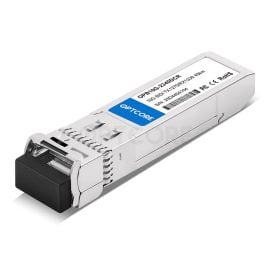 Generic SFP-10G-BX40-U Compatible 10G SFP+ BiDi 1270nm-TX/1330nm-RX 40km TransceiverUS$ 25.00 (Excl. VAT)
Generic SFP-10G-BX40-U Compatible 10G SFP+ BiDi 1270nm-TX/1330nm-RX 40km TransceiverUS$ 25.00 (Excl. VAT)
3. BiDi SFP28
BiDi SFP28 supports 25Gbps data speed. It is intended for 5 G frontal networks, 25G Ethernet, data centers, and telecom. Comparatively, 25G BIDI SFP28 is far less widely used than SFP and SFP+, so the cost is much higher than the other types.
The typical 25G BiDi SFP28 supports 10km, 20km, 40km, and 80 km distances. For less than 40 km, it usually uses 1270/1330nm. But For 80km, it uses 1295/1310nm.
-
 Generic Compatible 25G BiDi SFP28 1330nm-TX/1270nm-RX 10km TransceiverUS$ 36.00 (Excl. VAT)
Generic Compatible 25G BiDi SFP28 1330nm-TX/1270nm-RX 10km TransceiverUS$ 36.00 (Excl. VAT) -
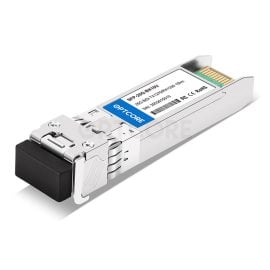 Generic Compatible 25G BiDi SFP28 1270nm-TX/1330nm-RX 10km TransceiverUS$ 36.00 (Excl. VAT)
Generic Compatible 25G BiDi SFP28 1270nm-TX/1330nm-RX 10km TransceiverUS$ 36.00 (Excl. VAT)
4. BiDi QSFP
BiDi QSFP is a relatively uncommon BiDi transceiver type. Most QSFP transceivers have an LC duplex or MPO fiber connector, which utilizes multilane and WDM technology. Unlike regular QSFP, BiDi types are typically referred to as the 40GBASE-SR-BiDi.
In this case, the QSFP still uses the LC duplex connector. However, it allows directional transmission on the single fiber for a 20G bandwidth and achieves a total aggregate bandwidth of 40G over two fibers. The general wavelength for the multimode fiber is 850/910nm.
5. BiDi QSFP28
The 100G BiDi transceiver mainly uses the QSFP28 form factor. Like the BiDi QSFP, this type uses an LC duplex connector, allowing directional transmission for 100G Ethernet interconnects. It provides an ideal solution for the single fiber upgrade of 10G bidirectional links to 100G without additional new fiber deployment.
-
 Generic Compatible 100G BiDi QSFP28 1304nm-TX/1309nm-RX 40km LC TransceiverUS$ 849.00 (Excl. VAT)
Generic Compatible 100G BiDi QSFP28 1304nm-TX/1309nm-RX 40km LC TransceiverUS$ 849.00 (Excl. VAT) -
 Generic Compatible 100G BiDi QSFP28 1331nm-TX/1271nm-RX 10km LC TransceiverUS$ 399.00 (Excl. VAT)
Generic Compatible 100G BiDi QSFP28 1331nm-TX/1271nm-RX 10km LC TransceiverUS$ 399.00 (Excl. VAT) -
 Generic Compatible 100G BiDi QSFP28 1271nm-TX/1331nm-RX 10km LC TransceiverUS$ 399.00 (Excl. VAT)
Generic Compatible 100G BiDi QSFP28 1271nm-TX/1331nm-RX 10km LC TransceiverUS$ 399.00 (Excl. VAT) -
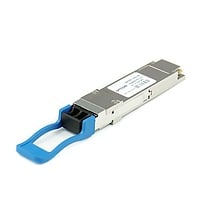 Generic QSFP-100G-SRBD Compatible 100G BiDi QSFP28 SR 850/910nm 100m TransceiverUS$ 219.00 (Excl. VAT)
Generic QSFP-100G-SRBD Compatible 100G BiDi QSFP28 SR 850/910nm 100m TransceiverUS$ 219.00 (Excl. VAT)
6. BiDi XFP
Although the XFP is outdated, a few clients and users still need the BiDi XFP module. Directional optics allows the user to save half of the fiber while providing the same bandwidth. Besides the difference in form factor and CDR function, BiDi XFP provides almost the exact specifications of SFP+ types.
-
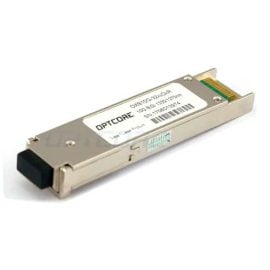 10Gb/s XFP BiDi 1330nm-TX/1270nm-RX 40km TransceiverUS$ 129.00 (Excl. VAT)
10Gb/s XFP BiDi 1330nm-TX/1270nm-RX 40km TransceiverUS$ 129.00 (Excl. VAT) -
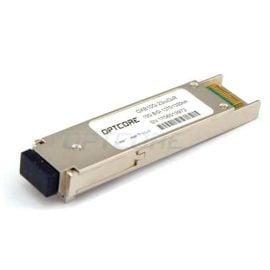 10Gb/s XFP BiDi 1270nm-TX/1330nm-RX 40km TransceiverUS$ 129.00 (Excl. VAT)
10Gb/s XFP BiDi 1270nm-TX/1330nm-RX 40km TransceiverUS$ 129.00 (Excl. VAT) -
 10Gb/s XFP BiDi 1330nm-TX/1270nm-RX 10km TransceiverUS$ 89.00 (Excl. VAT)
10Gb/s XFP BiDi 1330nm-TX/1270nm-RX 10km TransceiverUS$ 89.00 (Excl. VAT) -
 10Gb/s XFP BiDi 1270nm-TX/1330nm-RX 10km TransceiverUS$ 89.00 (Excl. VAT)
10Gb/s XFP BiDi 1270nm-TX/1330nm-RX 10km TransceiverUS$ 89.00 (Excl. VAT)
7. BiDi 1×9
The BiDi 1×9 is an older optical transceiver model that is still in use today. However, it can be challenging to find manufacturers that continue to produce this type of transceiver. Fortunately, Optcore still offers the BiDi 1×9 to customers worldwide at competitive prices and with fast delivery. We provide the BiDi 1×9 for telecom, Ethernet, and industrial control, covering speeds of 2Mbps, 10Mbps, 155Mbps, 622Mbps, and 1Gbps.
-
 1.25Gbps 1490nm-TX/1550nm-RX 80km BiDi 1×9 Industrial TransceiverUS$ 29.00 (Excl. VAT)
1.25Gbps 1490nm-TX/1550nm-RX 80km BiDi 1×9 Industrial TransceiverUS$ 29.00 (Excl. VAT) -
 1.25Gbps 1310nm-TX/1550nm-RX 20km BiDi 1×9 Industrial TransceiverUS$ 7.90 (Excl. VAT)
1.25Gbps 1310nm-TX/1550nm-RX 20km BiDi 1×9 Industrial TransceiverUS$ 7.90 (Excl. VAT) -
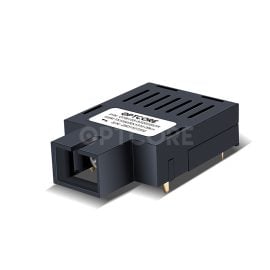 155Mbps 1550nm-TX/1310nm-RX 20km BiDi 1×9 Industrial TransceiverPrice range: US$ 6.70 through US$ 7.20 (Excl. VAT)
155Mbps 1550nm-TX/1310nm-RX 20km BiDi 1×9 Industrial TransceiverPrice range: US$ 6.70 through US$ 7.20 (Excl. VAT) -
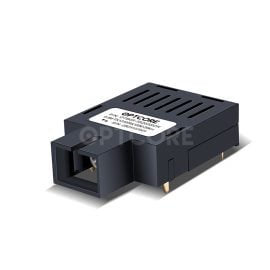 0.5Mb/500kbps 1310 or 1550nm 20km BiDi 1×9 Industrial TransceiverPrice range: US$ 17.50 through US$ 18.50 (Excl. VAT)
0.5Mb/500kbps 1310 or 1550nm 20km BiDi 1×9 Industrial TransceiverPrice range: US$ 17.50 through US$ 18.50 (Excl. VAT)
FAQs
Q: Do you have a multimode BiDi SFP?
A: Although only a few vendors supply it, we still meet unique clients’ needs for multimode fiber cabling directional applications. The typical distance for 1 G Ethernet is only 0.5km.
Q: Can we use the BiDi SFP+ and XFP together?
A: Yes, you can connect a BiDi SFP+ with XFP, but ensure they meet the correct wavelength and data speed. Otherwise, you will fail to build the connectivity.
Conclusion
BiDi transceivers help the service provider and users save on fiber cable deployment while providing double bandwidth. When fiber resources are limited, or it is difficult to lay new fibers, choosing the Bidirectional module is perfect. As an expert in the optical module, OPTCORE provides a total BiDi solution for various customers and is ready for you. Explore how OPTCORE can empower your projects and drive your business forward.
Read more:
- SFP+, SFP28, QSFP+, QSFP28, QSFP56, QSFP-DD, QSFP112 vs OSFP, What are the differences?
- Terabit BiDi MSA Overview: A Beginner Guide
- What is SFP Module? An Ultimate Guide
- What is SFP+ Module? An Ultimate Guide
- CWDM vs DWDM vs WDM: Differences & Similarities







